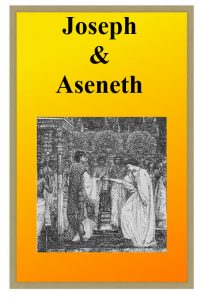Aseneth appears just three times in the Hebrew Bible, in Genesis 41 and 46:
41. 41. And Pharaoh said to Joseph, “Behold, I have set you over all the land of Egypt.” 42. Then Pharaoh took his signet ring from his hand and put it on Joseph’s hand, and arrayed him in garments of fine linen, and put a gold chain about his neck; and he made him to ride in his second chariot; and they cried before him, “Bow the knee!” Thus he set him over all the land of Egypt. 44. Moreover Pharaoh said to Joseph, “I am Pharaoh, and without your consent no man shall lift up hand or foot in all the land of Egypt.” 45. And Pharaoh called Joseph’s name Zaph’enath-pane’ah; and he gave him in marriage Aseneth, the daughter of Poti’phera priest of On. So Joseph went out over the land of Egypt . . .
50. Before the year of famine came, Joseph had two sons, whom Aseneth, the daughter of Poti’phera priest of On, bore to him. 51. Joseph called the name of the first-born Manas’seh, “For,” he said, “God has made me forget all my hardship and all my father’s house.” 52. The name of the second he called E’phraim, “For God has made me fruitful in the land of my affliction.”
46. 20. And to Joseph in the land of Egypt were born Manas’seh and E’phraim, whom Aseneth, the daughter of Poti’phera the priest of On, bore to him.
This information is tantalisingly brief. Who was this woman? How did Joseph come to meet and marry her? How could he, an upstanding Israelite, the son of Jacob, have married this pagan daughter of an Egyptian priest? Had he not struggled, only two chapters earlier, to avoid the lures of Potiphar’s wife? Where the Biblical narrative provided only hints, later interpreters became fascinated with these problems. Looking to fill in the gaps, they inferred what they thought must have happened. As they reflected on the few clues available, the story of Aseneth began to construct itself.
Joseph and Aseneth
Joseph and Aseneth
858 Downloads
Published: 10th July 2019
